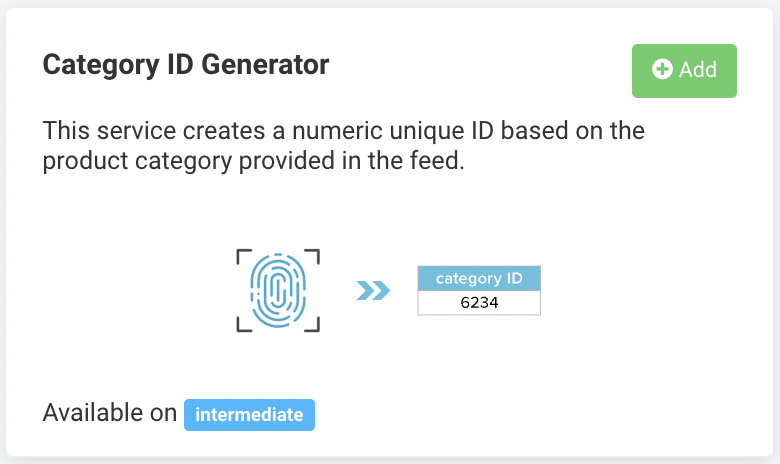Create unique IDs for categories with the Category ID Generator
Discover how to create unique IDs for your products' categories and category paths with the Productsup data service called Category ID Generator.
Introduction
Note
The Category ID Generator data service is available for the intermediate stage only.
The Category ID Generator is a data service in Productsup that creates unique IDs for product categories and category paths across an organization, project, or site. This data service scans your category attribute, identifies the delimiter used in the attribute, and creates an additional data source in your site to add and populate five (5) new columns:
___service_categoryid_pathids___service_categoryid_id___service_categoryid_path___service_categoryid_last___service_categoryid_hash
These columns let the platform:
Assign each category a unique ID.
Break each category down into category levels.
Assign each category path a unique ID based on the category levels it contains.
Applying the Category ID Generator service looks similar to this:
Category path | Category hash | Category path ID | Category ID | Last category level |
|---|---|---|---|---|
Clothes -> Homewear -> Home shoes -> Slippers | Clothes ->Homewear ->Home shoes ->Slippers | 1>2>3>4 | 4 | Slippers |
Clothes -> Accessories -> Socks | Clothes ->Accessories ->Socks | 1>9>10 | 10 | Socks |
Clothes -> Homewear -> Sleeping clothes -> Pajamas | Clothes ->Homewear ->Sleeping clothes ->Pajamas | 1>2>22>23 | 23 | Pajamas |
Your current category path is in the Category path column. A simplified version of it is in the Category hash column, which contains a technical value needed for the data service to complete its tasks. The Category path ID column combines IDs of different category levels into one category path ID. The Last category level column has the last category level of the path and usually determines the category ID shown in the Category ID column.
Note
The column names in this example don't coincide with those in Productsup. These are simplified column names.
The names of your columns depend on the column prefix you choose during the data service setup.
Prerequisites
Make sure you have set a unique item identifier to use this data service. See Set a unique item identifier for more information.
Add the Category ID Generator data service
Go to Data Services from your site's main menu and select ADD SERVICE.
Search for Category ID Generator, select Add, give it a desired name and column prefix, and select Add.
By default,
___service_categoryidis the column prefix.
Select the attribute that contains your products' categories in Category Column.
In ID pool based on…, choose the level within the platform that Productsup should scan for categories:
Account - Productsup assesses the uniqueness of all categories in your organization. Each unique category in this organization gets a unique ID. If multiple sites have a category with the same data, such a category receives unique IDs each time it appears in the organization.
Account (Distinct) - Productsup assesses the uniqueness of all categories in your organization. Each unique category in this organization gets a unique ID. If multiple sites have a category with the same data, such a category receives the same ID across all sites of the organization.
Project - Productsup assesses the uniqueness of all categories in the chosen project. Each unique category in this project gets a unique ID. If multiple sites have a category with the same data, such a category receives unique IDs each time it appears in the project.
Project (Distinct) - Productsup assesses the uniqueness of all categories in the chosen project. Each unique category in this project gets a unique ID. If multiple sites have a category with the same data, such a category receives the same ID across all sites in the project.
Site - Productsup assesses the uniqueness of all categories in the chosen site. Each unique category in this site gets a unique ID.
Tip
To use the options Account, Account (Distinct), Project, and Project (Distinct), add and set up the Category ID Generator in all sites where you want to create unique category IDs. The items selected in the drop-down menu ID pool based on… should be the same across all these sites.
In Tree Separator, enter the symbol that should separate levels within your category paths. The default separator is
>.Select Save.
For the platform to process a new data service, select Run in the top-right corner of your site's view.
Note
If you can't see your new category IDs in the intermediate stage in Data View, ensure the platform hasn't hidden them:
Go to Data View from your site's main menu and choose the relevant stage or export in the drop-down list on your left.
Select the menu icon on the right and then select the eye icon.
Find the attributes in the list that use the custom prefix
___service_categoryidand select the eye icon next to each attribute you want Data View to display.Close the pop-up menu.
The naming of the attributes created by the Category ID Generator depends on the column prefix you choose in Step 2. The attribute names the data service generates always start with three underscores (
___), which means the platform doesn't send such attributes to your export channels.
Edit the Category ID Generator data service
Go to Data Services from your site's main menu.
Search for your data service.
Select the cogwheel icon (⚙) next to the desired data service to edit settings.
Select Save.
Delete the Category ID Generator data service
Go to Data Services from your site's main menu.
Select the cogwheel icon
 next to the desired data service.
next to the desired data service.In the Danger Area panel, select Remove this service.
Select Yes.